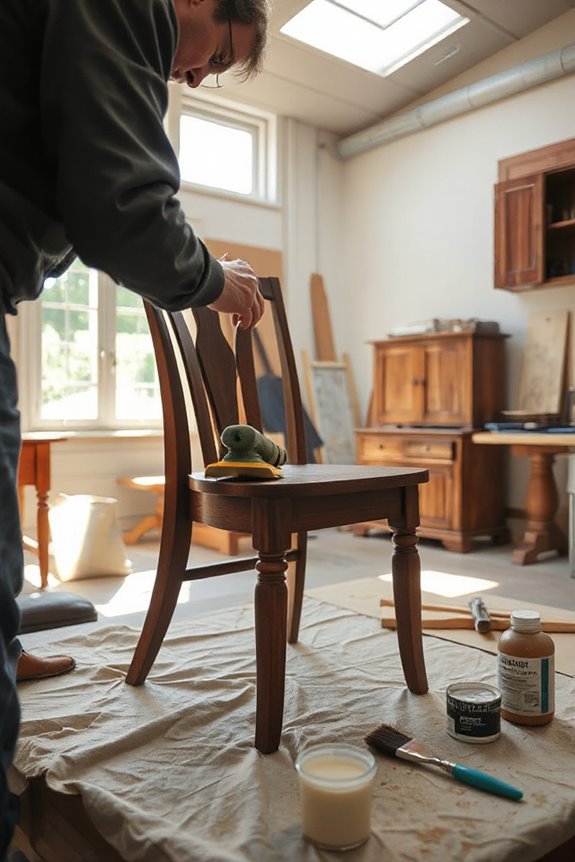Got a sagging sofa? Don’t worry, you can fix it! Start by checking the frame for damage—weak frames can cause serious sagging. You can tighten springs with a vice grip or even add plywood for extra support under those cushions. And hey, remember to flip and rotate cushions regularly! It helps even out wear. Want to know more tricks to keep your furniture looking sharp? Stick around for some easy maintenance tips!
Key Takeaways
- Inspect the frame for damage and reinforce weak spots to enhance stability.
- Tighten sagging springs with vice grip pliers to restore support.
- Regularly flip and rotate cushions to evenly distribute wear and prolong lifespan.
- Add extra layers of foam or batting to cushions for enhanced comfort and shape retention.
- Place plywood support under cushions to provide additional firmness and stability.
Identifying the Cause of Sagging Furniture
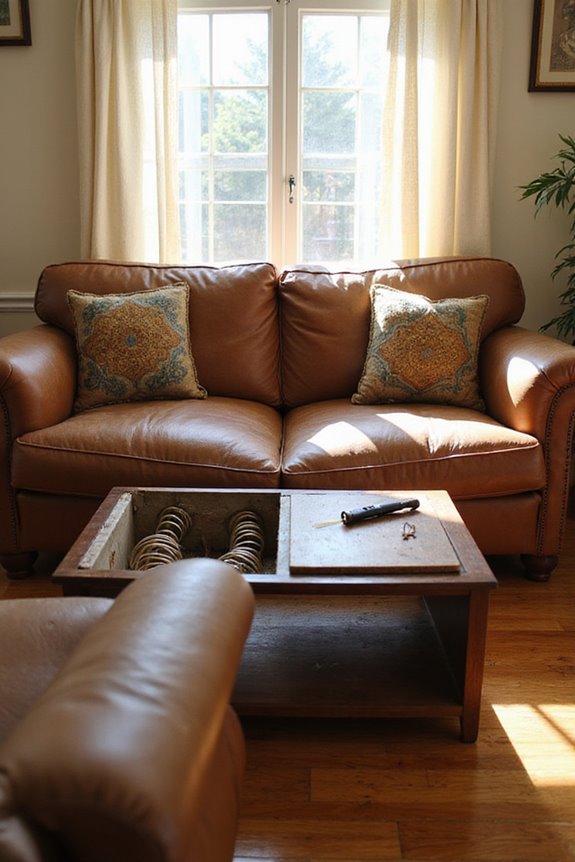
When you notice your furniture sagging, it can be pretty frustrating! You might wonder what’s causing it, right? Common causes can stem from the material types used in your furniture. For instance, high-quality foam can degrade, losing its shape after just a few months! Have you ever sat repeatedly in the same spot? That can lead to sagging, especially with fabrics like cotton or linen, which absorb moisture and relax over time.
Then there’s the frame quality—if it’s made from low-quality materials, it can weaken quicker than you think! And let’s not forget about those springs! A compromised spring system can definitely contribute to the problem. Identifying the cause is the first step to a sag-free sofa! Additionally, modular designs can help minimize sagging by providing more support and allowing for easier rearrangement of cushions.
Effective Prevention Strategies
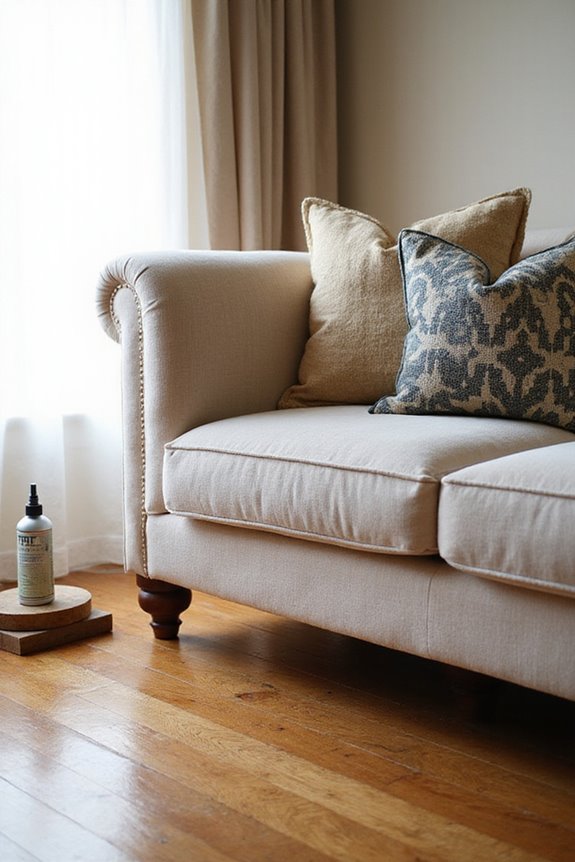
To keep your furniture looking great and sag-free, it’s all about the right strategies! First, investing in quality materials is key. That sturdy hardwood frame? It really makes a difference! Wouldn’t you rather have cushions with high-density foam that resist compression?
Regular maintenance is another preventive measure. Clean your upholstery often to keep it fresh, and try conditioning leather every 6 to 12 months. You definitely want to avoid letting dust and dirt take their toll!
Also, consider your usage habits. Are you plopping down on your sofa? Gentle sitting can prevent wear and tear, too! By following these simple practices, you’ll help your furniture last longer while looking fabulous. Who doesn’t want that? Additionally, opting for modular designs can enhance both comfort and versatility in your living space.
Practical Solutions for Sagging Sofas
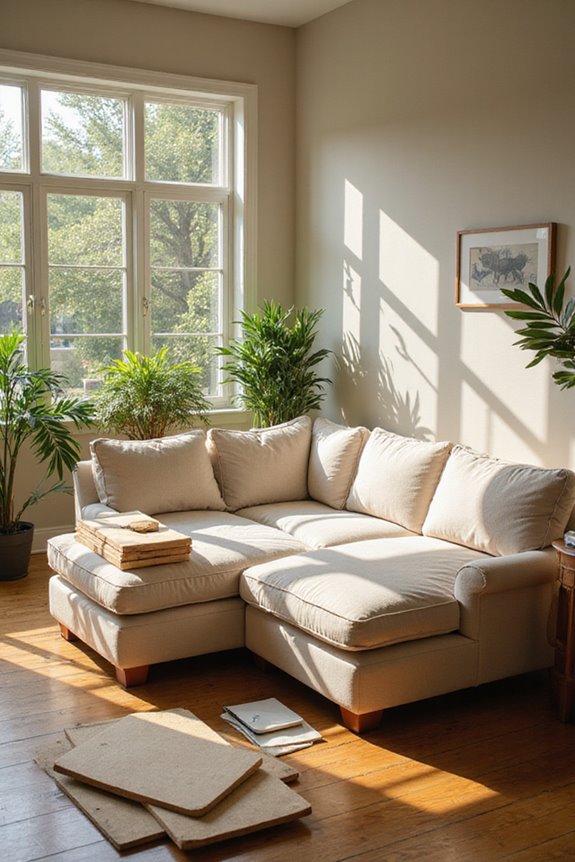
If you’re dealing with a sagging sofa, don’t fret—it’s easier to fix than you might think! Start by inspecting the frame for any damage. Can you see any weak spots? Tighten sagging springs with vice grip pliers for extra support!
Next, consider cushion replacement. Flip and rotate cushions regularly to help distribute wear. Got some foam lying around? Add extra layers or batting to plump those sad cushions up.
And hey, if you’ve got hidden zippers, use them! Adjust your cushion fillings without needing to remove the covers—that’s a win! Want more comfort? Try using a plywood support under the cushions for a little extra stability. Additionally, modular designs can help enhance the adaptability of your couch setup. Easy fixes can make your sofa feel brand new!
Maintenance Tips for Longevity
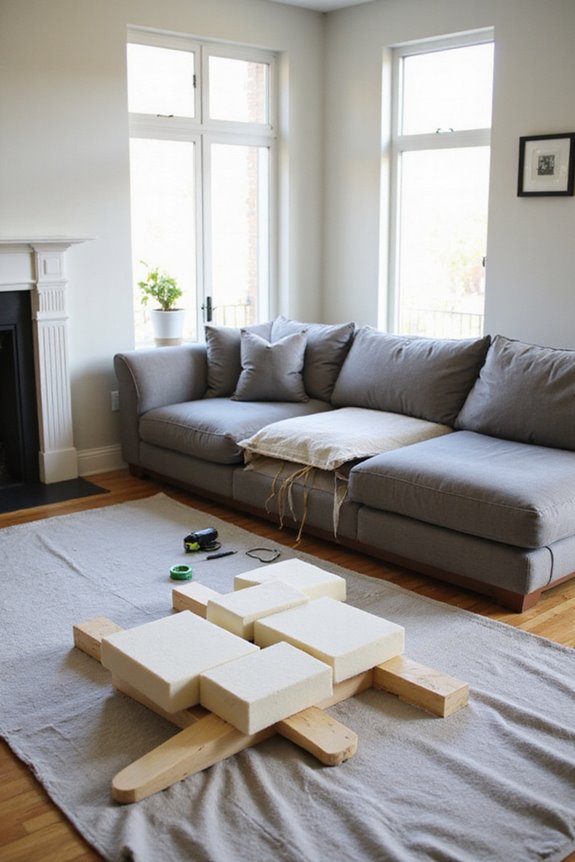
Taking care of your furniture can feel like a chore sometimes, but it doesn’t have to be! By sticking to a simple maintenance routine, you can keep your pieces looking great for years. Start by dusting regularly with a soft cloth—easy, right? And don’t forget to tackle spills immediately to avoid stains.
Using coasters and protective pads can save your surfaces from scratches. Have you checked screws and bolts lately? Tightening them up guarantees stability.
Also, watch out for sunlight! Position your furniture away from direct rays or use curtains to prevent fading. With these easy tips, you’ll give your furniture the love it deserves! High-quality materials ensure that your furniture remains durable and comfortable over time. Isn’t that worth a little effort?
Enhancing Comfort and Ergonomics
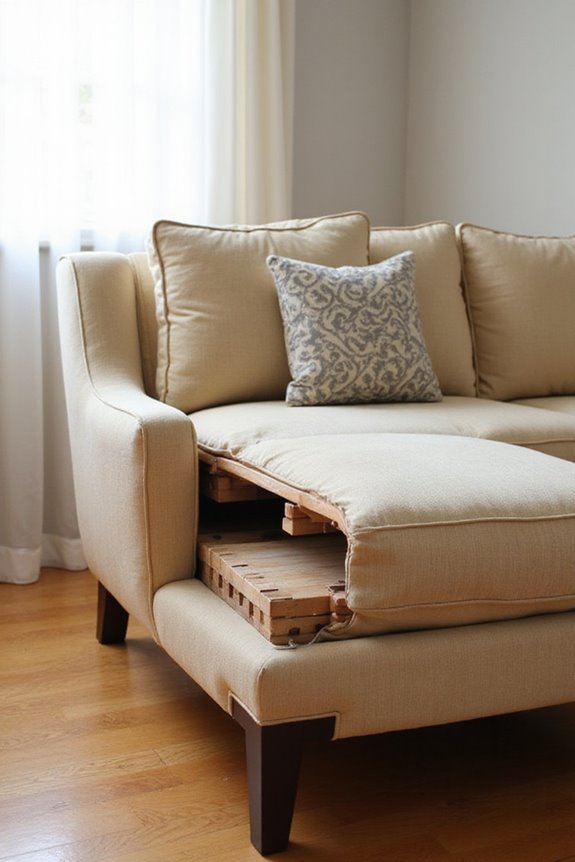
When it comes to furniture, comfort isn’t just a bonus—it’s a must-have! How often do you find yourself adjusting in your seat, wishing it fit better? Ergonomic seating is your best friend here. Imagine a chair that cradles your spine and supports that perfect ‘S’ curve. With adjustable height and depth options, you can personalize it for maximum comfort enhancement.
Ever thought about the distance from your knees to the seat’s edge? It matters! And don’t forget about those armrests—good ones can relieve shoulder strain. Plus, furniture that encourages movement can keep you energized. Additionally, a recliner with adjustable lumbar support can further enhance your overall seating experience. So, are you ready to elevate your comfort and embrace a healthier, happier seating experience? Let’s get started!
Frequently Asked Questions
Can Professional Services Repair Sagging Furniture Effectively?
Did you know that 85% of antique furniture can be restored? With professional upholstery and furniture restoration, you can effectively revive your sagging pieces, ensuring they’re not only usable but beautiful for years to come.
How Do I Know When to Replace My Furniture?
You’ll know it’s time to replace your furniture when you notice significant wear, discomfort, or persistent odors. Understanding furniture lifespan and watching for these replacement signs will help you make the right decision.
Are There DIY Methods for Fixing Sagging Chairs?
Yes, there’re DIY methods for fixing sagging chairs. You don’t need professional help. Just add chair reinforcements, like wooden boards or Pex tubing, under sagging cushions for instant support and improved comfort.
How Can I Prevent Sagging in New Furniture?
To prevent sagging in new furniture, focus on furniture maintenance. Regularly rotate and fluff cushions to enhance cushion support. Invest in high-quality materials and avoid direct sunlight to maintain integrity and prolong its lifespan.
What Types of Materials Are Best for Preventing Sagging?
Imagine your favorite chair, sturdy like an oak tree. To prevent sagging, choose high-density foam cushions and hardwood frames. These materials uphold comfort and support, much like trusted friends through the tests of time.


